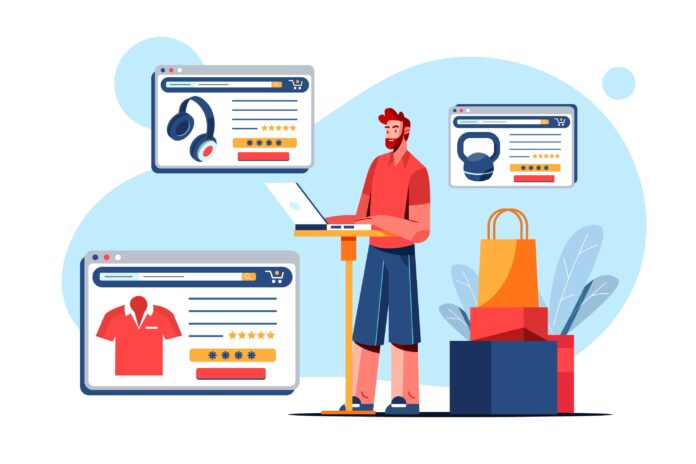If you want to convert website visitors into consumers, it’s critical to have a good eCommerce web design. In an ideal world, your website’s design features would make the shopping experience and purchasing procedure as simple, quick, and stress-free as possible.
You could be losing key clients if your online store is not optimized for sales, no matter how brilliant your online marketing are. You could also be squandering your ad expenditures if users leave your site as soon as they arrive. For that, we require effective ecommerce web design that will bring you good sell.
Below are some tips to make b2c web design more effective so that it will bring more sales.
Ecommerce Web Design Tips
1. You have to keep the user in mind
From product pages to product photos to contact forms, every component of your ecommerce website design is important. To the checkout page could influence a user’s choice to purchase something. Your storefront should make the finest possible first impression.
That is why, when it comes to the design of your ecommerce web design, you must keep the user in mind at all times. The importance of the user experience in converting visitors into customers and customers into repeat customers cannot be overstated.
2. Inclusion of reviews and/or testimonials
Sixty-one percent of online customers say they read customer evaluations before making a purchase. You may take advantage of this useful information by putting reviews and testimonials directly on your website. Customer reviews are a simple and effective approach to boost sales and conversions. Product-specific reviews can be seen just beneath each product’s description, which is an effective ecommerce web design concept. If you don’t have a lot of distinct products, you can make a separate page for reviews and testimonials on your website.
3. Products should be organized on website
You should categorize your products on your website into distinct categories. To make the search process easier, categories should be easily accessible via a menu bar. This can also provide users with a glance into product categories they were previously unaware of. This ecommerce store’s menu bar lists a variety of product categories, including accessories, gadgets, and more.
When a user selects one of these categories, they can further refine their search by selecting more particular criteria such as electronic kind or brand. This is beneficial because even if someone visits their website in search of a vehicle part, they will be able to find it.
They may wind up purchasing a piece of jewellery or another item that they were unaware was available on the website.
4. Users should allow to filter products

When it comes to search bars, you can increase your ecommerce site’s search capabilities by adding filters. Nothing is more frustrating than locating the ideal pair of shoes online only to discover that the store does not carry your size.
Allowing users to filter your products is the most effective approach to prevent falling into this trap. Size, color, brand, and price are all popular search filters. This allows consumers to search your website for the product they’re looking for while also guaranteeing that the results they get are as precise as possible.
5. Flow should be natural
You want visitors to your site to be able to find and purchase the things they desire as quickly as possible.When developing your ecommerce site, keep the natural flow of the eye in mind. People tend to browse webpages in an E or F configuration, according to studies and heat maps. Beginning at the top-left corner and moving horizontally across the page, then down the left side, horizontally again, and so on. This is why most website navigation menus run horizontally across the top of each page. Use the E formation in your ecommerce website design to direct users’ attention to the most important conversion points.
6. Grid layout looks good
Grid-style layouts are ideal for ecommerce sites, as well as most other websites. It’s best to keep things sorted in rows and columns when users are exploring them.
Just make sure there aren’t too many different products in a row. To keep your product catalogue pages visually appealing, we recommend only having three or four products per row. Leaving plenty of white space around each item offers people room to breathe and helps them distinguish between things.
7. Contact information
If a visitor to your site has a query or issue, they’ll most likely look for a “contact us” page or, if you’re looking for contact information, scroll down to the bottom of your homepage.
Make it as simple as possible to find your contact information. You don’t want to lose a customer because you forgot to include an email address or phone number on your website’s homepage!
It’s best to offer as much information about yourself as possible. There are numerous possibilities here, including an email address, a phone number, hours of operation, and a contact form that users can use to give…an email, or even a widget that allows users to submit a Facebook message directly to your firm from your website.
8. Mobile optimization
A bit more than half of all websites are accessed on mobile devices. And as smartphones and tablets get more powerful, that number is only anticipated to rise.
One of the worst mistakes you can make is failing to optimize your ecommerce web design for mobile use. In fact, Google recognizes the necessity of having mobile-friendly websites so strongly that it created the Mobilegeddon algorithm specifically for it.
Your ecommerce website’s responsive design allows it to adjust to any screen size or operating system. As a result, you won’t have to bother about creating a distinct mobile version of your site for each device. Simply ensure that your image sizes, CTAs, and form fields work across all platforms.
9. FAQ page
Are you tired of continuously responding to client inquiries? Incorporating a FAQ page into your website’s navigation menu does more than just help with product questions.
However, it can help your website visitors trust you more. What methods do FAQ sites use to build trust? They show your visitors that you are trying to be as transparent as possible with your products and/or services.
They also show that you are serious about answering questions and suggest that you are a skilled customer service representative… and actually, care about assisting individuals in their search for information.
People are more likely to make a purchase from a company that appears to be trustworthy and skilled. The use of FAQ pages might also help with site navigation.
You may have noticed that the majority of popular ecommerce companies have buttons on their websites that link to their social media accounts. Incorporating social media symbols into your ecommerce web design encourages customers to stay in touch and fosters longer-term customer/brand relationships.
It’s also been established that including social media links on your website improves your search engine rating! If you don’t want customers to leave your website, make sure the links open your social network accounts in a new tab.
11. Utilization of simple website design
Aesthetically appealing and trustworthy websites are usually ranked higher than visually complex websites. If you want to improve the conversion rate of your ecommerce website, consider streamlining it.
To make your ecommerce website’s design more simple. Remove any extraneous information and opt for a basic design with lots of empty space.
Most ecommerce websites feature a small shopping cart symbol on every page, as you’ve surely observed… (typically in the upper right corner) that allows consumers to quickly see what they’ve placed to their shopping cart.
This is one of the most crucial aspects of ecommerce web design! It has been proved that having this button visible at all times while people are shopping online increases conversion rates. Just make sure the icon is something recognizable, like a shopping cart or a shopping bag, and that it refreshes in real time.
The last thing you want to do is cause folks to become confused. Because this is one of your website’s most crucial buttons. We recommend picking a strong color that contrasts with the background to make it stand out. It should also be larger than other buttons to make it the easiest to locate and thus improve the ecommerce experience.
13. Quality photos and images
It is essential to have high-resolution photographs. Any pixilation or blurriness can make potential customers think your goods is low-cost. Consider making photo galleries for each product so that users can scroll through them and see numerous perspectives of the item.
A pop-up box where visitors may zoom in on a specific image and observe tiny details is a popular feature. This is the closest you can come to allowing visitors to physically pick up and inspect a product before purchasing it.
Users can effortlessly explore your website’s pages to discover what they’re seeking for using menu bars. For greatest convenience, the menu should be on all pages, preferably at the top. To suit the F format, menu bars are sometimes vertical down the left side of the page. Just be careful not to overcrowd your menu with choices, since this will make it appear cluttered and confused. If your website has a lot of different categories and pages. You may categorize them more readily with a drop-down menu without producing sensory overload.
15. Quick and simple checkout
A difficult checkout experience is the number one cause of cart abandonment. There are a few simple techniques to make your ecommerce development site’s checkout procedure easier. Allow people to check out as guests, for starters. When too much information is asked of them in order to complete a transaction, people get sceptical. Furthermore, requiring users to register a full account on your site can turn them off faster than you can say “cart abandonment.”
Only ask for the information you need, such as a shipping address, name, and payment information. There’s no need to ask for an address if your goods or service is totally digital because it won’t be transported anyplace. Additionally, be sure to explicitly identify your payment gateways as well as the payment choices available to them.
16. Honesty about pricing
The best policy is always to be honest. Always be straightforward and honest about the price of the products or services you’re selling while establishing an ecommerce web design.
Don’t try to conceal content or make it tough to find on your website. You don’t want your website visitors to think they’re being duped or manipulated. Putting pricing information on difficult-to-find pages of your website can backfire. Instead, put it somewhere where it will be easy to find and comprehend.
This regulation applies to shipment as well. Always be honest about shipping charges and any shipping policies that your customers may need to know about. According to studies, presenting shipping information too late in the purchasing process increases cart abandonment.
Conclusion
Designing an ecommerce website might be challenging, but now that you’ve learned the top web design tips for ecommerce web design, you’ll have everything you need to create a site that not only looks great but converts like crazy. Creating an e-commerce site doesn’t have to be expensive, but staying current in the business necessitates practice.
Continue to discover new things. Keep a watchful check on your progress at all times. Take surveys to find out what works and what doesn’t for your target audience. Conversions aren’t easy; keep in mind that you’ll need to work hard and be patient to see results. So, what do you have to lose? Use these pointers to give your online store the facelift it needs.


